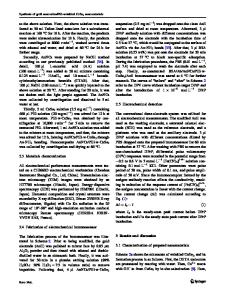Electrochemical synthesis of polyaniline nanocomposite based on modified gold nanoparticles and its application for elec
- PDF / 1,406,557 Bytes
- 11 Pages / 595.276 x 790.866 pts Page_size
- 109 Downloads / 531 Views
ORIGINAL PAPER
Electrochemical synthesis of polyaniline nanocomposite based on modified gold nanoparticles and its application for electrochemical aptasensor Masoud Amiri 1,2 & Farhad Golmohammadi 2 Received: 1 April 2020 / Revised: 6 June 2020 / Accepted: 8 July 2020 # Springer-Verlag GmbH Germany, part of Springer Nature 2020
Abstract The method of synthesis of polyaniline, as an important conductive polymer, and the conjugated metal nanomaterials applied in the polymer, determines the physicochemical properties of the final composites. In this study, we developed one-step electrochemical synthesis of new polyaniline, via applying modified gold nanoparticles (MAuNPs) as a weak acid. To this end, the Au nanoparticles were modified with 11-mercaptoundecanoic acid, and then they were directly applied as counter anions for the synthesis of a composite polyaniline. The steps of synthesis and the nanocomposites were studied by transmission electron microscopy (TEM), scanning electron microscopy (SEM), UV-vis spectroscopy, Fourier transform infrared spectroscopy (FTIR), dynamic light scattering (DLS), cyclic voltammetry (CV), and electrochemical impedance spectroscopy (EIS) techniques. This composite polyaniline was applied as an electrochemical aptasensor for the sensitive determination of lysozyme in human serum and urine. The aptasensor showed linearity range between 0.2 ng mL-1 n 2.0 ng mL-1 with detection limit of 120 pg mL-1. Keywords Conductive polymer nanocomposites . Polyaniline . Metal nanoparticles . Aptasensor
Introduction One of the most interesting materials for designing the advanced electrochemical (bio)sensors, electrocatalysts, energy storage devices, etc., is conductive polymers [1–6]. For decades, polyaniline, a well-known conductive electroactive polymer, has been applied in a wide variety of applications due to its unusual properties [7–11]. Most of the time, polyaniline is composited with other (nano)materials to produce favorable materials. For example, polyaniline was composite with nanoparticles such as iron and cobalt nanoparticles [12], gold nanoparticles [13], bacterial cellulose [8], TiO2
Electronic supplementary material The online version of this article (https://doi.org/10.1007/s10008-020-04761-5) contains supplementary material, which is available to authorized users. * Masoud Amiri [email protected] 1
Department of Chemistry, Tarbiat Modares University, Tehran 14115-175, Iran
2
Department of Chemistry, Faculty of Science, Islamic Azad University Kermanshah Branch, Kermanshah, Iran
[14], etc. However, the properties of a composite of polyaniline are not merely determined by these nanomaterials. Briefly, the electrochemical and physical properties of such composites are influenced by the nature of these (nano)materials as well as the conditions of polymerization of polyaniline [15–17]. The nature of π-conjugated chains of polyaniline, molecular packing, structure of polymers, and its intrinsic conductivity, are controlled by parameters such as the dopant anions (an anion whi
Data Loading...











